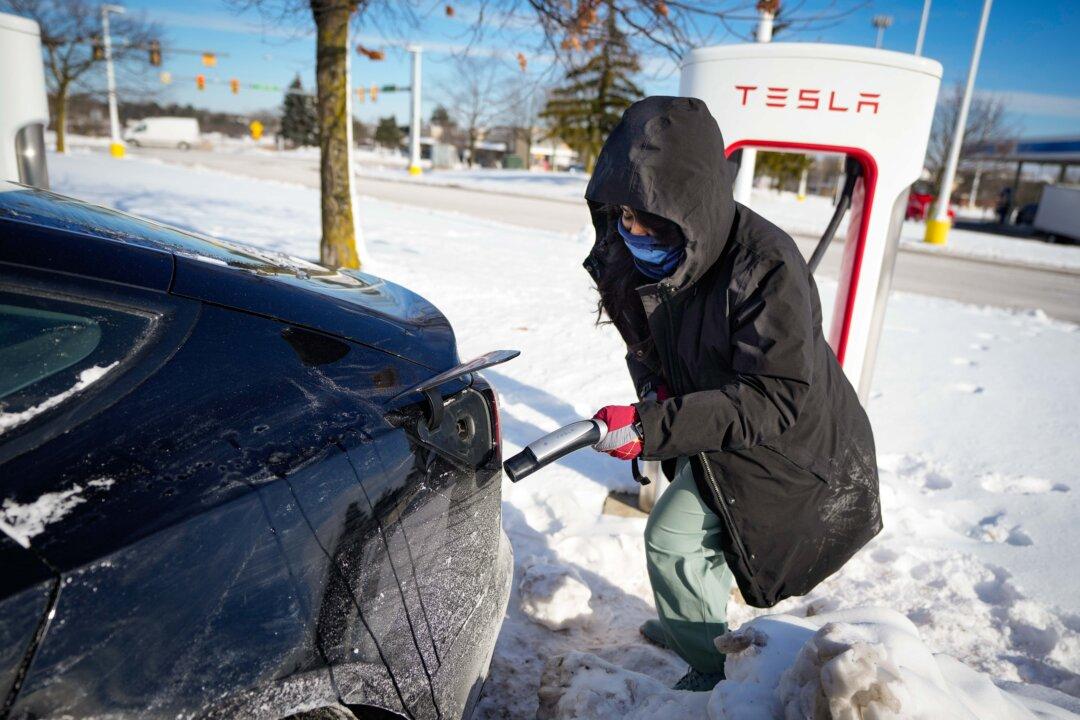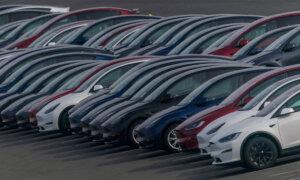MESA, Ariz.—Behind all the aggressive marketing of electric vehicles lies a promising technology that’s still a work in progress, says James Haas, used car manager at Berge Toyota in Mesa, Arizona.
Electric vehicles (EVs) are still costly to produce and maintain, he says. Many don’t hold their value like gasoline-powered cars do, and most consumers still can’t afford to buy them with an average $40,000 price tag.
And, good luck finding a charging station in the middle of nowhere. Still, the Biden administration seems driven to replace gasoline vehicles with EVs by the next decade, Mr. Haas says.
The government’s stated goal is to achieve net-zero carbon emissions to combat climate change.
While the auto industry continues to ramp up EV production to compete against manufacturers like Tesla, market observers say that acceptance of the technology could be faster to keep pace.
According to the June 2023 Cox Automotive survey, many consumers are still leery of purchasing an EV despite growing interest.
The 2023 Path to EV Adoption: Consumer and Dealer Perspectives study revealed a “lack of EV readiness among U.S. automotive dealers regarding sales and service,” according to Cox Automotive.
“As EV inventories continue to climb, dealers must bridge this gap.”
The survey polled 1,024 consumers and 152 dealers. And while consumer interest in purchasing an EV appears to be increasing, price remains the “top roadblock.”
Fifty-one percent of consumers in the survey said they would consider buying an EV in 2022, compared with 38 percent in 2021. Forty-three percent said an EV was too expensive in 2022, and 32 percent voiced concern over the lack of charging stations in their area.
Among the reasons to buy an EV, 73 percent noted fuel savings while 53 percent reported climate-friendly EV technology. A whopping 91 percent said they already had an EV model in mind before they purchased it.
On the dealer side, the study found that 45 percent of respondents said EV models have yet to prove themselves in the consumer market. Less than half of these dealerships said they felt “extremely prepared” to sell or service electric vehicles.
“There is a significant gap in readiness between consumers and dealers in terms of embracing electric vehicles,” Cox Automotive wrote.
Against a backdrop of questioning EV buyers, state and federal governments are committed to transitioning the nation to electric vehicles by the next decade.
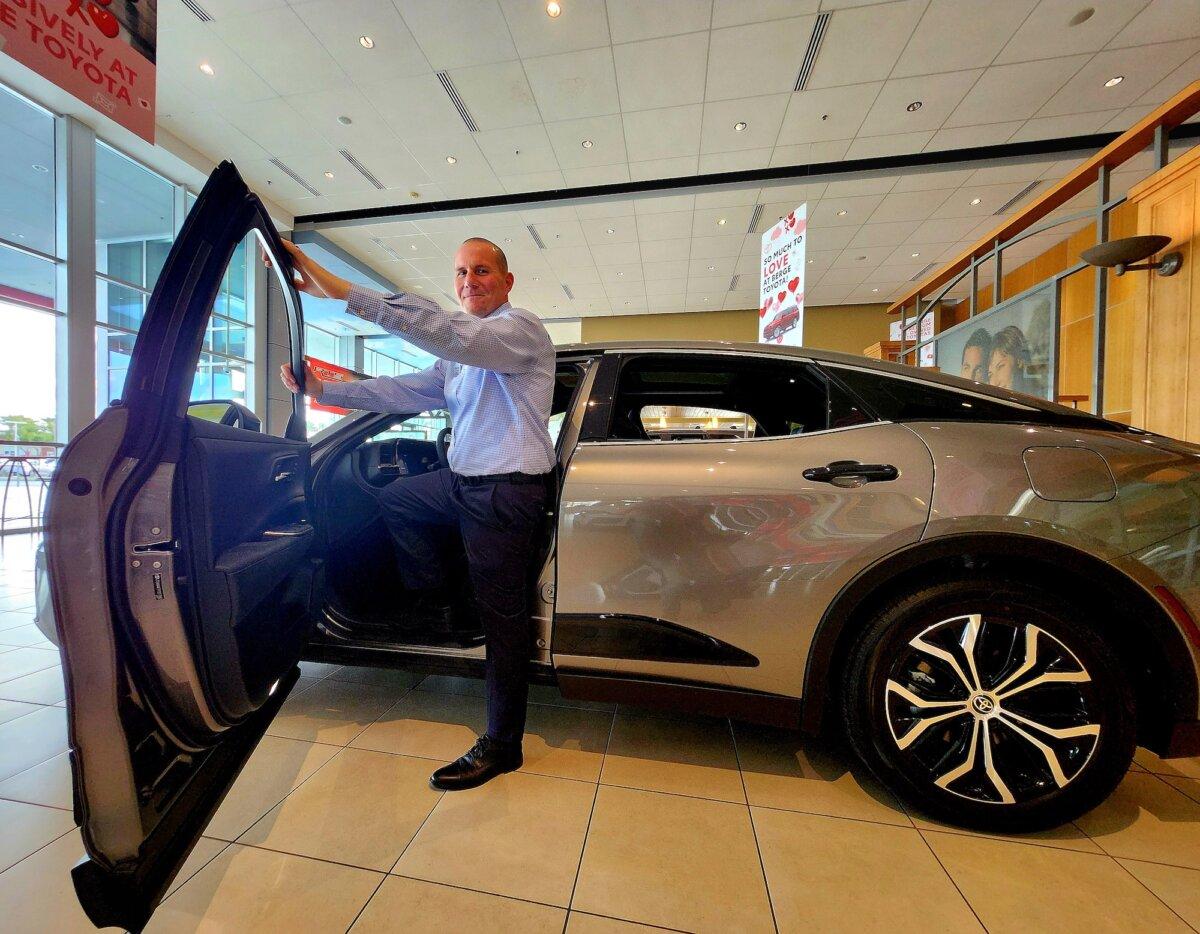
James Haas, used-car sales manager at Berge Toyota in Mesa, Ariz., stands in front of a traditional gas-powered vehicle on Feb. 1, 2024. Allan Stein/The Epoch Times
California’s zero-emissions rules, for example, recently mandated that all vehicles be plug-in by 2035.
Mr. Haas said the switchover has been anything but smooth.
“Within a month, they were blacking out the state because they didn’t have enough electricity to make it through the summer,” Mr. Haas said.
“None of it made any sense. The infrastructure is not there.”
The U.S. Environmental Protection Agency policy wants at least two-thirds of vehicles sold to be electric by 2032.
Mr. Haas said that in the current market many consumers trading in electric vehicles “don’t even have a plug” at home.
“They end up plugging them in at work. I hear the negative because it’s people trading out. They got stuck enough times when they had to pull over.”
In an October 2023 Car Gurus report, electric vehicle inventories increased 506 percent from 2022 due to higher purchase prices despite generous tax breaks and government incentives.
On average, electric vehicles sat in the lot for 82 days compared with 64 days for traditional gasoline vehicles, Car Gurus wrote. Another concern was the upfront cost of installing in-home chargers—$2,000 in some cases—and higher insurance costs.
Many electric vehicles have technical problems that are challenging to fix, Mr. Haas told The Epoch Times. “But they’re trying to make them for everybody.”
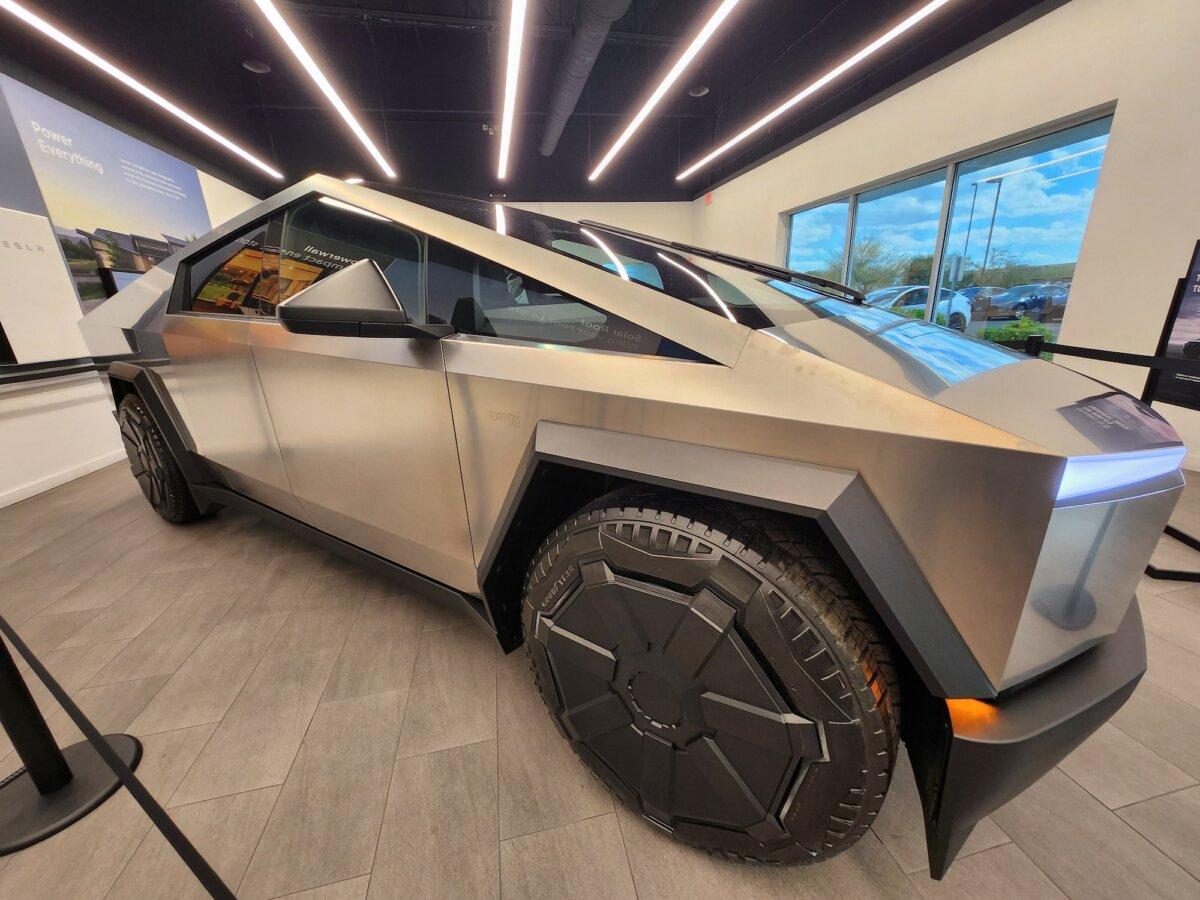
A 2024 Tesla all-wheel-drive vehicle sits in the display room at a Tesla dealership in Phoenix, Ariz., on Feb. 1, 2024. The truck sells for $100,000. (Allan Stein/The Epoch Times).
“As a used car director, most of the trades we see were very brief [periods of ownership]—three to six months.” Owning an EV “has to be an exact lifestyle,” and make sense from a consumer standpoint, he said.
“A lot of [dealers] have problems rushing them to the street without any real history of doing it.”
As electric vehicle manufacturers continue to churn out new models, many dealers hope that newer features, better mileage, and improved performance will attract more buyers.
In 2024, General Motors (GM) introduced the Sierra EV Denali Edition 1, a 754-horsepower pickup truck with a 400-mile range before needing to recharge.
The vehicle boasts a charging time of 100 miles in 10 minutes, using an 800-volt public direct current fast charging station.
The kicker, however, is the Sierra EV’s $107,000 sticker price, although GM plans to launch an affordable version in two years at roughly half the cost.
In the meantime, the company sees strong consumer growth and demand in 2024, said David Caldwell, GM’s director of finance and sales communications.
“Sales of EVs from GM’s brands increased 93 percent in the U.S. in 2023,” Mr. Caldwell told The Epoch Times.
“Across the industry, EV sales had a record year. We will build to demand, and we are encouraged that many third-party forecasts have U.S. EV deliveries rising from about 7 percent of the industry in [2023] to at least 10 percent in 2024, which would mean another year of record EV sales.”
The Wall Street Journal, however, reported in early February that despite upbeat sales forecasts, automaker Ford would earn 50 percent more profit if it stopped making electric vehicles.
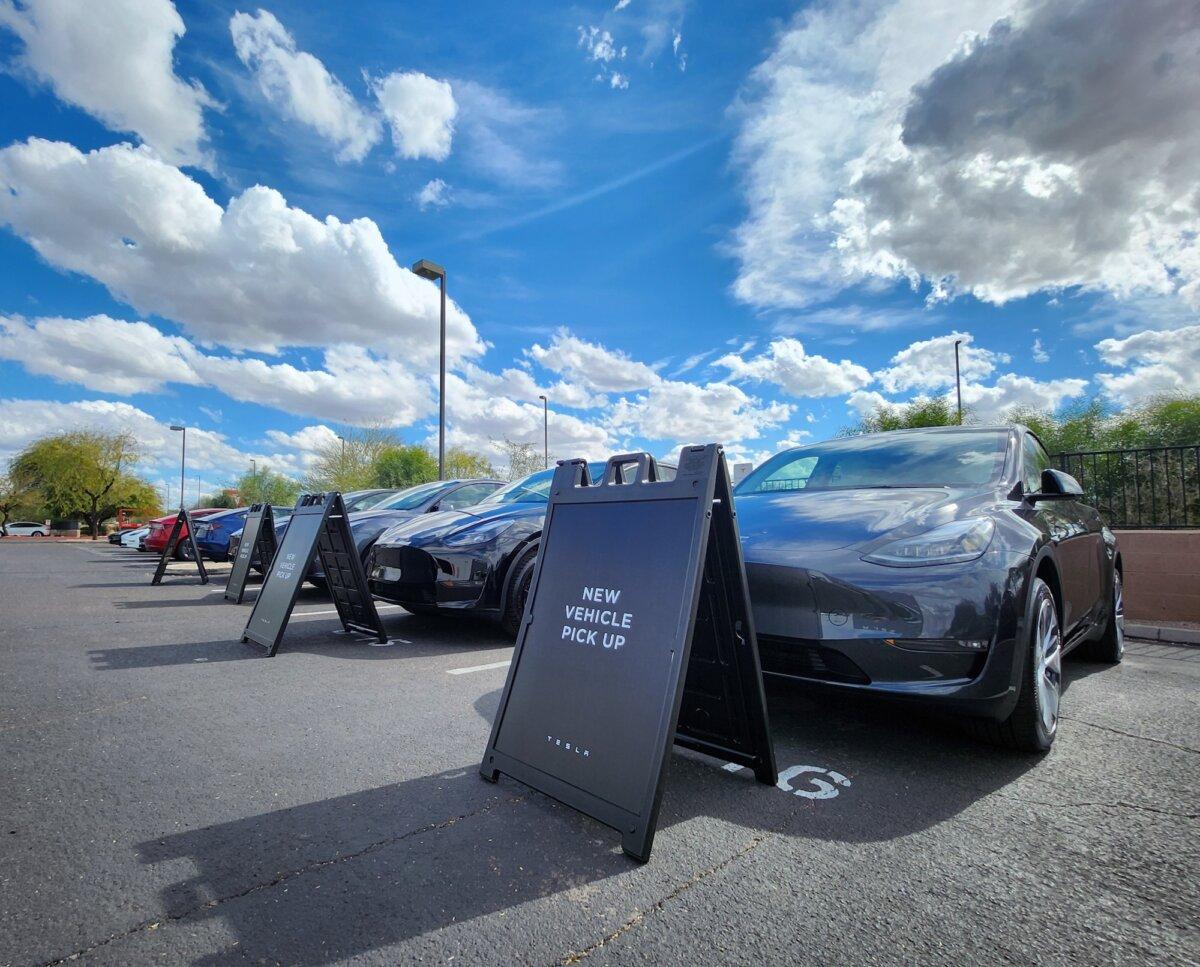
Recently sold Tesla cars wait to be picked up in the parking lot in Phoenix, Ariz., on Feb. 1, 2024. Allan Stein/The Epoch Times
In the current market, the company’s electric-powered pickup trucks and SUVs were still too big and heavy to create efficiency as electric vehicles, the Journal noted.
Structural defects have also plagued the electric vehicle and hybrid industry in recent years.
In July 2022, Ford announced it was recalling as many as 100,689 electric vehicles with hybrid drive trains due to the risk of engine fire.
Models included the 2020–2022 Ford Escape, 2021–2022 Lincoln Corsair, and 2022 Ford Maverick.
In January, some Tesla owners in Chicago became stranded while charging their vehicles because the battery wouldn’t charge properly in sub-zero weather.
“In cold weather, vehicles use more energy to heat the battery and cabin, and it’s normal to see energy consumption increase,” Tesla wrote on its website.
The company said it had made several updates to improve performance in freezing temperatures, “including better overall thermal performance, quicker supercharging, and improved cabin conditioning.”
Tesla did not respond to a request for comment from The Epoch Times.
Rental EVs
While many auto rental companies have begun introducing electric vehicles to their fleets, Hertz recently announced plans to slow its adoption of electric vehicles, citing higher-than-expected repair costs.
A tow truck taking away a burned Tesla after the electric vehicle caught fire on a California highway on May 6, 2023. Courtesy of KCRA via CNN
In announcing the 2023 third-quarter earnings report, Hertz CEO and Chairman Stephen Scherr said the company saw a 13-percent profit at $359 million.
“The exception remained vehicle damage costs, particularly those on our EVs, which we are addressing in a very targeted way,” Mr. Scherr said, according to a meeting transcript.
“Let me share a bit more context on the damage equation. First, while conventional maintenance on electric vehicles remained lower relative to comparable [gasoline] vehicles in Q3, higher collision and damage repairs on EVs continue to weigh on our results and negatively impact [earnings].
“Nonetheless, there’s an undeniable transformation underway. The share of new electric vehicle sales in the U.S. is growing and studies of current EV ownership evidence lower incidence of damage and collision than for [internal combustion engine] vehicles, not higher as we are experiencing. We believe these trends will converge.”
Enterprise is another nationwide auto rental company that believes electric vehicles will play a “critical role” in the future of ground transportation.
“Enterprise embraces the responsibility to transition its fleet to electric vehicles—and is committed to doing so thoughtfully,” the company wrote on its website.
The company said a survey conducted in 2021 found that 12,000 of Enterprise’s fleet vehicles were “good candidates” for electrification.
“Electrifying these vehicles could save $33 million and eliminate 194,000 tons of tailpipe carbon dioxide over a four-year service life,” the company wrote. “By 2025, about 42,000 vehicles could be electrified. Over four years, cost savings could reach $167 million, or about $4,000 per vehicle, and carbon dioxide emissions could drop by 1.3 million tons.”
Nissan and Toyota’s corporate headquarters did not return emails from The Epoch Times seeking comment.
Driving Costs
The National Automobile Dealers Association (NADA) reported in February 2023 that the average cost to drive an electric vehicle 15,000 miles was $4,295, about half the cost of powering a gasoline car.EV owners spend about $300 less on vehicle maintenance over five years, or $4,246, according to NADA.
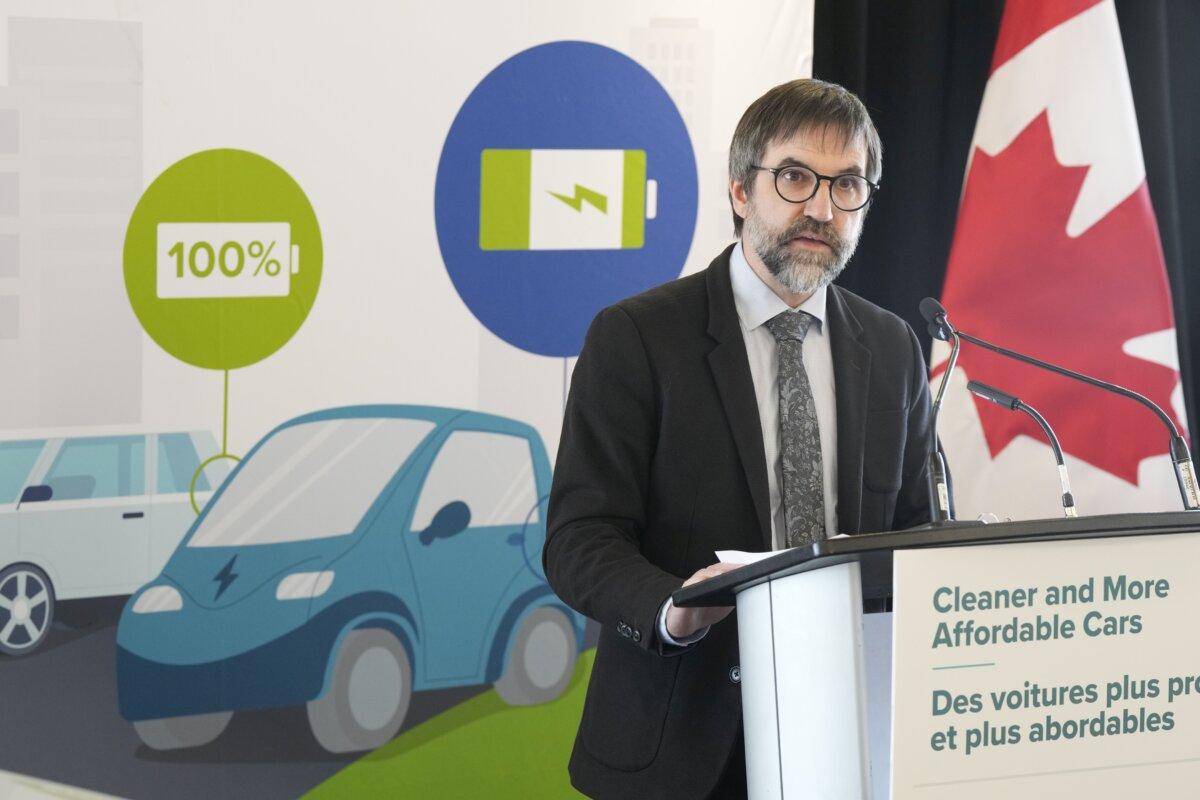
Canadian Environment Minister Steven Guilbeault outlines the details of his plan to eventually phase out the sale of gas-powered vehicles in Canada, in Toronto on Dec.19, 2023. The Canadian Press/Frank Gunn
In terms of vehicle depreciation, market analysts say that electric vehicles lose an average of $43,515 compared with $27,883 for gasoline vehicles.
The average cost for insurance is also higher: $6,824 for electric vehicles versus $5,707 for gas-powered cars.
Car and Driver found that maintenance costs per mile tended to be lower among electric vehicles.
For the gas-powered Hyundai Kona, Car and Driver discovered that the cost was about 10 cents per mile, or $4,428, compared with the Hyundai Kona Electric at 8 cents per mile, or $3,573.
Even so, some big auto manufacturers like Toyota remain focused on producing “hybrid” models over electric vehicles.
Mr. Haas noted robust sales of the Toyota Prius and Rav 4. He said the reason is simple: “You can put gas” in a hybrid vehicle and enjoy many benefits of owning an electric vehicle.
“You’re talking 40 to 50 miles to the gallon. You maintain it like a normal car,” he said, adding that to say an electric car has no maintenance is not exactly true. “They still have their technicals.”
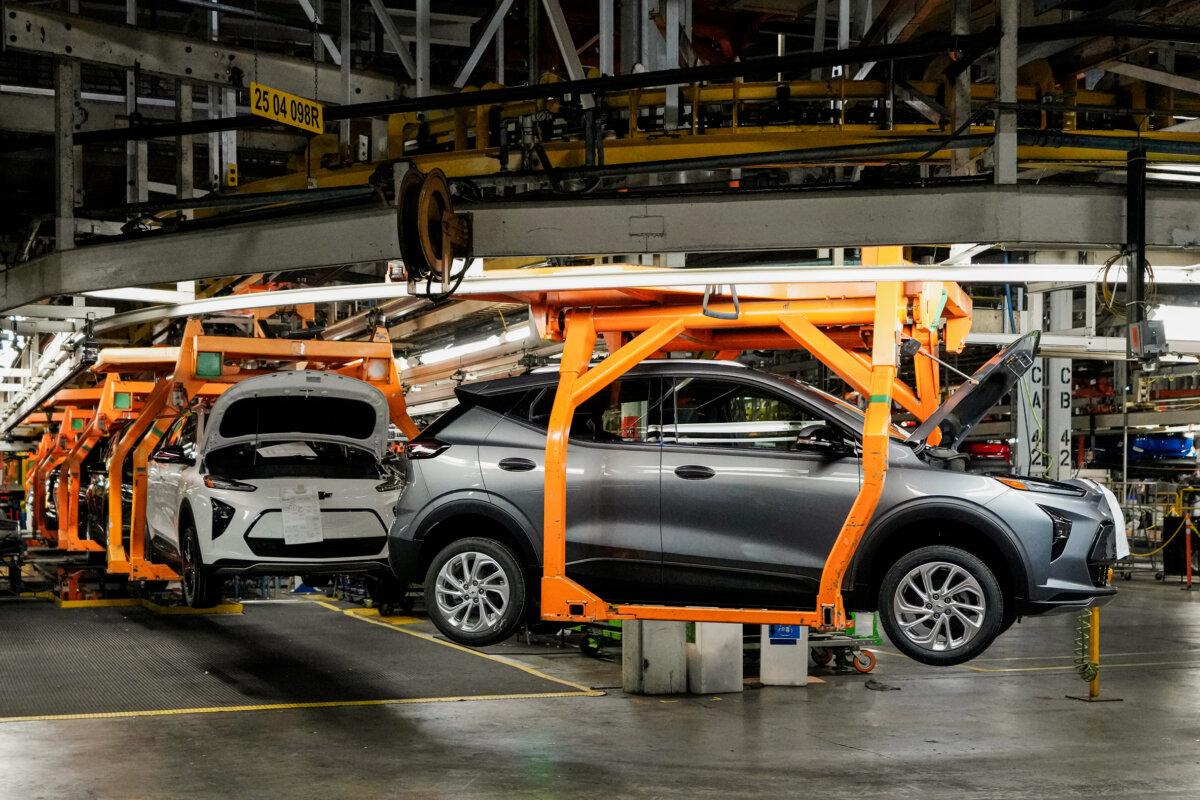
Vehicles move along the 2023 Chevrolet Bolt EV and EUV assembly line at the General Motors Orion Assembly in Lake Orion, Mich., on June 15, 2023. Despite new electric vehicle sales hitting a record in the United States this year, sales growth is starting to slow and fall short of the auto industry's lofty ambitions to transition away from combustion engines. AP Photo/Carlos Osorio, File
Mr. Haas said his department doesn’t accept some electric vehicle trade-ins because of their rapid decline in value.
That’s not so much the case with hybrids. Mr. Haas said he’s taken Prius models in trade with 350,000 miles logged on their odometers.
“Our hybrids have never gotten to the point where there are 15 on the lot,” he said. “We turn them. We don’t keep them in stock. The hybrids turn.”
“At one point, I could take in a Tesla and sell it for $4,000 or $5,000 over retail within a week. Now, Tesla has dropped 20 percent over the past couple of years.”
Based on his sales experience, Mr. Haas foresees a balance of electric and gasoline vehicles on the nation’s highways.
“Some people love them,” he said of EVs. “I have two friends with Teslas, but I don’t think it’s going anywhere near where [Tesla] thought it would.”
